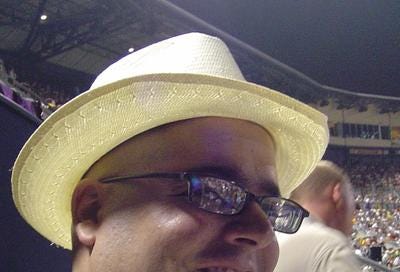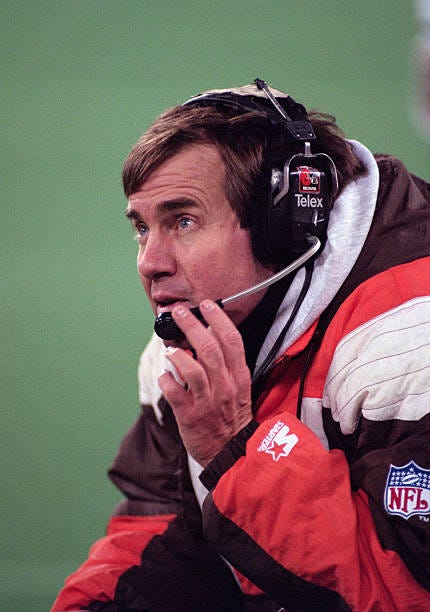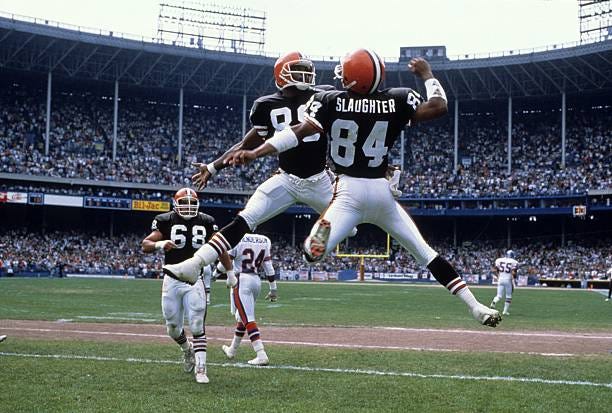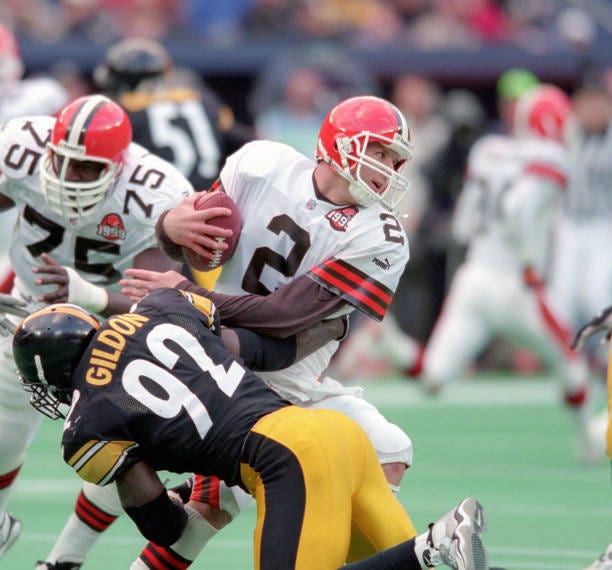With new book 'Weird Moments in Cleveland Sports' out, author Vince Guerrieri chats about highs, lows and the strange saga of his beloved Browns
While Cleveland sports fans have seen their share of heartbreaks over the years, along with a few triumphs (see: 2016 Cavaliers), there’s no denying professional sports in northeast Ohio has been nothing short of interesting. Perhaps a little weird, too.
Having followed Cleveland sports for decades, journalist and author Vince Guerrieri has witnessed many of the glorious highs, soul-crushing lows and all-around goofiness that makes sports in Cleveland so intriguing. Guerrieri takes a deep dive into the perplexities of Cleveland sports in his latest book, “Weird Moments in Cleveland Sports.”
Naturally, the Browns are a major theme in Vince’s work and the writer took some time out of his busy schedule talk to 80s/90s NFL Rewind on the book writing process, the near misses of the ‘80s Browns, why the team left Cleveland in the ‘90s, and how things have gone so wrong since the Browns returned to the league in ‘99.
NFL Rewind: You’ve had quite an interesting career. You’ve worked as a reporter, editor, dabbled into PR, freelancing and you’ve written books. Can you talk a bit about your background?
Vince Guerrieri: I’m a Youngstown (Ohio) native and I’ve spent most of my life in northern Ohio. About 10 years ago, I started seriously getting into some magazine work and I’ve written for a variety of regional and national publications. I do a good amount of freelancing. Fortunately, I work for a paper that’s family owned, and the rule of thumb is you can never freelance for a competing publication. “Weird Moments in Cleveland Sports” is my third book. I’ve written two and have co-wrote another. This was my pandemic project. It was basically crowd-sourced on Twitter. I developed an outline and all of a sudden I had a lot of free time and no sports to watch, so I developed this. I turned the (manuscript) in last March and the publish date was November 2022. It’s been out for three months and change and I feel like it’s found a decent audience.
NR: What prompted the idea for “Weird Moments in Cleveland Sports” and how long did it take for the project to come together?
VG: Cleveland sports fans are a strange breed. There are a lot of moments that were really fun and unfortunately there were moments that weren’t a lot of fun. Being a fan of anything, if it’s not your job on some level, it should be fun. If our teams do not provide that fun for us, we must provide it ourselves. A lot of that consists of “Hey, remember when this goofy thing happened?” We were having that conversation; it was so lengthy with so many different moments that I thought, hey, I could probably get an outline out of this. If you’re writing a non-fiction book, you can sell it (to publishers) based on an outline and a couple of sample chapters. I had an outline put together and started pitching it around April of 2020. Gray Publishing, a local company in Cleveland, does non-fiction books about northeast Ohio. I sent a pitch to them, they liked the idea and decided to pursue it. It took a little less than two years from inception from when I submitted a manuscript. I wasn’t really working on a hard deadline because the publishing industry, like a lot of industries, had supply-chain issues to deal with.
NR: In Cleveland sports, what classifies as a “weird” moment?
VG: The short answer is anything that makes you stop and say, “I can’t believe that just happened!” Admittedly, that covers a lot of ground. One of the things we did in the process (of working on the book), is we tried to divide things up, not by sport, not by era, but group things together. It runs the gamut. There are strange injuries, there are bone-headed moments on the field, off the field, bad coaching, bad owners… whatever you think.
NR: When I started watching football in the late ‘80s, the Browns were one of the top teams. Hard to believe considering the state of the team the past two decades. Do you think those ‘80s Browns teams should have won a couple of Super Bowls?
VG: I think everybody forgets how good they were because it’s been such dread since. They probably should have at least gone to one Super Bowl, and I feel like had they’d gone to one, then the Browns wouldn’t have moved. The whole issue of the Browns moving was the stadium and even if they’d have gone to one, a whole deal would have been done and there would have been enough good will for a new stadium to be built for the Browns and we would have been spared that unpleasant re-location process.
NR: What was the more crushing moment in Browns’ history: Ernest Byner’s fumble in the 1987 AFC Championship Game or Brian Sipe’s game-ending end zone interception in the 1980 Divisional Playoffs?
VG: That’s a really tough one. The thing about the fumble is that the Browns were dead and buried in the first half of that AFC title game. If it weren’t for Ernest Byner, the Browns wouldn’t even be in that game. Unfortunately, what we get is he’s remembered as the guy who fumbles. That is not even remotely fair. But that was THE game. They win that game; they go the Super Bowl. “Red Right 88” was a divisional series game. That was not the conference championship. There’s a lot of people who say, “Yeah, if the Browns would have won that game, they would have gone to the Super Bowl,” but they still would have had to play another game.
NR: After the late 80s’ run ended, the Browns struggled, went through a couple of coaching changes and ended up hiring a young defensive guru named Bill Belichick as head coach in ‘91. Besides one playoff season in ‘94, Belichick didn’t have much success in Cleveland. Why?
VG: When he got there the cupboard was bare. The coach of the Browns in the late ‘80s, through their biggest success period, was Marty Schottenheimer. Marty ended up parting ways; it was more a clash of personalities than firing him because he wasn’t good at his job. When they fired Marty, Bud Carson became the head coach. Carson was defensive coordinator. He was one of those coaches who was a very good coordinator, but not a great head coach. They went to one AFC Championship Game with Bud, and that’s the one nobody remembers because it was quite frankly an ass-kicking.
The year after that, they ended up going 3-13, which at the time, was the worst record the Browns had ever had. They were running out of talent. Byner went to Washington where they won a Super Bowl; that Dog Pound defense was starting to fade… they end up bringing in Belichick. He brought in a lot of retreads from his days with the Giants. He was really trying to put together a team in his own image. Mark Bavaro was in Cleveland for a year, Pepper Johnson was in Cleveland for a while. …. Belichick has two mediocre years and then came ‘94 when they put it all together. They went 11-5, got in the playoffs as a wild card. That Wild Card game was the last playoff game Cleveland has hosted. They beat the Patriots and lost to the Steelers in the Divisional Round.
Going into ‘95, fans were thinking this team could be a legitimate Super Bowl contender. Around October, the team was hovering around .500, when word got out that they were moving. They were going to move to Baltimore the next year and the wheels just fell off. They won one more game after word got out. It was the final game at Cleveland Stadium and they beat the Bengals.
The NFL approved the move to Baltimore. Shortly after that, (team owner) Art Modell said, “We need a clean break from Cleveland,” and fired Belichick. Modell’s tenure of owning the Cleveland Browns/Baltimore Ravens included firing Paul Brown, who may have been the greatest coach ever who engineered the modern NFL. Fired Marty Schottenheimer, fired Forrest Gregg who went on to take the Bengals to the Super Bowl and then, after he left Cleveland, fired Bill Belichick, too.
NR: I remember watching games as a kid during that ‘95 season, looking in the Municipal Stadium stands, and seeing “Go to Hell, Art Modell” signs in the crowd.
VG: And those were the polite ones…
NR: Ha, I can imagine. Do you think he gets too much of the blame for the franchise moving out of Cleveland?
VG: I believe Art Modell is in the Ninth Circle of Hell with the rest of the betrayers, does that answer your question? No, I don’t feel like he gets too much of the blame. He gets all of the blame that he deserves. Being the owner of an NFL team in Cleveland should be a license to print money and it wasn’t for him. Even if you take what he said at face value, “I have no choice but to move to Baltimore.” Well, he moved to Baltimore, got everything he wanted, and still had to sell the team. He had to sell the team because he was not “liquid” enough to own an NFL team at that point. That’s the real agony of it. If he would have said, “Listen, I need to bring in somebody who has deeper pockets than I have,” and he would have been an owner emeritus with like 2 percent of the team, and everything unfolded for Cleveland in the 2000s like they unfolded in Baltimore, not only would he be in the Hall of Fame, but there’d also be a statue of him in front of the Browns’ stadium. Instead, he says “I have to leave to get what I want.” He still doesn’t get what he wants. Everybody remembers all the stupid stuff he did in Cleveland, but in Baltimore, because they see the headlights instead of the taillights when the Colts left, he’s a hero.
Baltimore was wrong when the Irsays moved the Colts out of town. Apparently, they believed two wrongs make a right because they turned around and did the same thing to Cleveland.
NR: Through the years, I’ve heard about Cleveland being a “Browns town.” How difficult was it when the Browns pulled out and left?
VG: People called me like I had a relative die. It was absolutely… crushing. There’s no other way to put it. It was awful. Here’s the thing: the NFL said we’re getting an expansion team. You get to keep the name, colors and team’s history, and nobody did that out of charity. The reason that deal was struck is because when (Robert) Irsay left Baltimore, the Colts did not have a lease in place, so he was able to leave and set up shop in Indianapolis fairly quickly. Modell broke his lease to move the Browns to Balitmore, and it was entirely possible that he was going to be sued into oblivion because of that. That’s when the NFL stepped in and said, “We’re going to engineer this settlement.”
The team ended up coming back in ‘99 and we figured that after a few years, the Browns would be back after it. For God’s sake, we’d just watched the Jaguars and the Panthers, both expansion teams in 1995, and within two years they were in their respective conference championship games. We had no reason not to believe things wouldn’t get better for the Browns. They haven’t. The team has been wandering through the desert for close to 25 years. They’re good for one winning record a decade.
NR: The Browns have only made the playoffs twice (2002 and 2020) since returning to the NFL 24 years ago. Why can’t the organization ever seem to get it right?
VG: That’s a really good question and I don’t have a great answer. The owner of the expansion Cleveland Browns was Al Lerner, who had actually been a minority partner with Art Modell with the old Browns. Well, he died back in ‘02 and the Browns made the playoffs that season, losing a Wild Card game to the Steelers. Randy Lerner, Al’s son, inherited the team and held onto them just as long as he had to before he sold it. With the Lerner’s and somewhat even Jimmy Haslam, I welcome their ownership because they were the anti-Modell — they could cover every check they wrote. Randy Lerner engaged in some benign neglect, he wanted to find somebody who could run the show and make the right decisions and they just kept whiffing on that. For a while, it looked like (general manager) Phil Savage and (head coach) Romeo Crennel was the right answer, right up until they weren’t. Eric Mangini only got two years; and he was on a short leash anyway because Randy Lerner ended up giving the keys to the castle to Mike Holmgren. Holmgren wanted to bring in his own people — they all ended up being stiffs. Pat Shurmur does a decent job as a coordinator and they say, “Oh, we should give him a head coaching job.” Well, they do that, and everyone sees why he shouldn’t be a head coach ever again.
Randy Lerner then sold the team to Jimmy Haslam and he’s demonstrated a very itchy trigger finger. Unfortunately, he’s made many, many, many bad decisions. And you can’t just say it’s been one person. They’ve changed coaches, they’ve changed general managers, they’ve changed owners, and nothing seems to work.
NR: Where can readers find “Weird Moments in Cleveland Sports?”
VG: It’s available online through Barnes & Noble, Amazon, and through Gray Publishing, so you can buy it directly through them as well.
NR: Any ideas for another book? What are your plans going forward?
VG: I’m going to put my energy into promoting this book for the time being. I just wrote more than 60,000 words for this book so I’m not in a hurry to sink deep into another large-scale project.
Follow Vince on Twitter @vinceguerrieri and read his work at vinceguerrieri.com.








